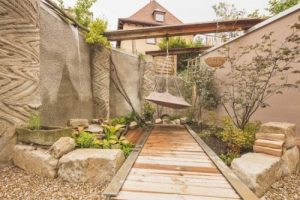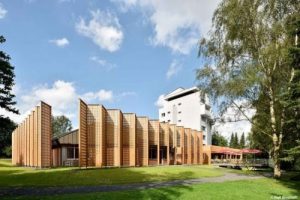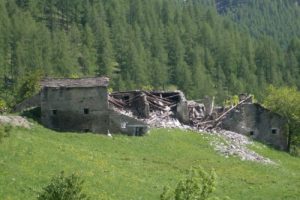Though often time it is a favorable approach to demolish a building to rebuild it according to ecological standards, it is not the most sustainable one.Restoration and renovations prevent demolition and avoid the use of new building materials. In addition, the charm of the old structures can be sustained. Today we introduce exciting architecture projects of our Green Pearls® partners.
Creativity wanted!
When rebuilding Creativhotel Luise the team focused on sustainability. The aim was an energy-efficient renovation based on the standard KfW55 and at the same time an upgrading of the rooms for the guests and the installation of comfortable lounge areas.

The team around hotel owner Ben Förtsch took up all these challenges with creativity: In order to meet the requirements for the insulation of buildings, a part of the foundation of the hotel had to be excavated. This area was converted into an atrium for the guests reusing existing material. A bridge of old timber beams and plant tubs made of former boilers are only two examples. Through upcycling a lot of garbage could be saved.
By the way, the clear and transparent communication of a long-term building site is of great importance for the guests as well as the residends to avoid any misunderstandings. Creativhotel Luise developed some creative ideas: surprise boxes in the rooms, information at the reception of the hotel also for the neighbors and a building site assessment system.
Old meets new at the Sturm reloaded

The connection of tradition and modern age is a matter close to the heart of the team of the Biohotel Sturm located in the Rhön region. The hotel is run by the family in the second generation, though a lot has changed in the last 40 years ago. The sustainable basic idea which is a recurring theme within the entire hotel should also become visible in the building itself.
Together with architect Matthias Löbermann the hotel planned the transformation. The former Sturm tower with the red bricks was covered with white mineral lime mud, followed by a modern timber cladding to improve the appearance of the entrance area. While the reception was modernized with natural materials like silver fir, the old pineal room was preserved and transformed into a comfortable reading room. The big garden area with natural swimming pond and nibbling garden invites to stay and relax.
Stone on stone – from the foundation up to the roof

The owners of the today’s Sagna Rotonda in Piedmont had to go even further: Only the foundation of the old hamlet from the 17th century existed. With a lot of love and passion Giovanni and Teresina rebuilt the village. A family from the neighboring village advised on the rebuilding of the façade, for the renovation inside and the electrical system Giovanni was responsible.
The idea from the beginning was an environment-conscious restoration, so only natural materials were used. Wood and stone dominate the architecture, it was insulated with cork and lime. A solar plant on the roof makes the small village energy-self-sufficient. A specific feature is the small sauna built by Giovanni which can be used today by the guests privately, who are impressed by the many thought-out details: From the indirectly illuminated glass stones in the rest area up to the small cold-water basin and the tea bar.
Objective: Preserve the original Viennese charm

A new building cannot always be avoided, however, sustainable measures should be integrated from the very beginning. Two Thai Resorts show what is possible: The Keemala in Phuket also known as a villa wonderland put the preservation of adult trees in the focus when planning the resort. Thus, it was built round the trees and today the trees also grow sometimes through the roofs and pools.
At the Tongsai Bay on Koh Samui not a single tree was felt when starting with the construction in 1987 and the local topography was taking into account at every step. To preserve the nature and integrate the resort into the environment, it was also built around nature. Trees grow through the middle of the balcony and the interior of some cottages is decorated with boulders. In addition, new trees are continuously planted and the living space of the animals and plants is protected.
















